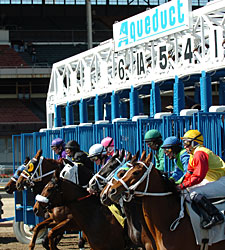NYRA Plan Won't Recommend Changes at Aqueduct

The agenda for the Nov. 12 meeting of the board of the New York Racing Association was short and sweet: to discuss a re-privatization plan for the organization due next spring to the office of New York Gov. Andrew Cuomo.
And while board chair David Skorton cautioned that no decisions would be made at the meeting, the biggest news was about a decision that has already been made—that is, to make no recommendations about the future of Aqueduct Racetrack.
Established in October 2012 following the state takeover of NYRA, the reorganization board was given three tasks to accomplish during its three-year tenure: enhance the guest experience, improve the quality of racing, and prepare a plan for re-privatization.
With a deadline of April 2015 to present a reorganization plan that would be implemented six months later, the board was widely believed to be in favor of closing Aqueduct as a cost-saving measure. The cessation of racing at Aqueduct would enable Genting Resorts Worlds Casino New York City, which opened on the site of the Aqueduct grandstand in October 2011, to expand.
But Christopher Kay, NYRA chief executive officer and president, said no such recommendation would be a part of the plan to be presented by the current board.
"We are to serve on this board for three years," Kay said, "but with respect to these real estate issues, particularly as they relate to the continued operation at Aqueduct and Belmont, that's a decision that will have longterm and significant impact on those communities as well as the entire state of New York, for several decades.
"We determined that it would not be appropriate for a temporary and transitional board like ours to make the decisions that will have such a longterm and permanent effect on not only NYRA, but the communities we serve and the horse racing industry in this state."
At the same time, Kay and NYRA chief financial officer Susanne Stover pointed to financial losses at Aqueduct, caused by drops in pari-mutuel handle due to bad weather and the inability to close the Aqueduct barn area for an extended period of time. Aqueduct was closed for training only during the Saratoga Race Course meet this year.
As a result of those losses and the decline in the horse population, Kay suggested that although racing will continue at Aqueduct, the possibility of fewer racing days—a minimum of which is now required by New York statute—is something he will discuss in an upcoming meeting with the New York State Gaming Commission.
He also said increased barn capacity at Belmont Park will make it easier to close Aqueduct for training for a longer period of time in 2015.
Kay and Stover reported that NYRA expects to end 2014 with $1.5 million surplus, exclusive of video lottery terminal revenue from the Genting casino. They said it would be NYRA's first operating surplus in 13 years, a result of an increase in revenue from this year's Belmont Stakes (gr. I); an increase in the cost of the simulcast signal and admission prices; and a decrease in labor costs.
They also said they expect increased surpluses in 2015 and 2016, based on current budgetary and revenue projections. The 2015 budget, Kay said, was based on a six-day racing week at Saratoga from July 24 to Sept. 7, putting to rest rumors of an extended five-day meet that would begin earlier in July.
And while Kay stressed the goal of operating with a surplus irrespective of VLT revenue, he also emphasized that NYRA is entitled to it. "Over a billion dollars of real estate was conveyed to the state," he said, "and in return, there are VLT revenues to pay for it."
Led by general counsel Joseph Lambert, the board also discussed possible governance structures for reorganization. Lambert said it will be a private, not-for-profit model as current state statute requires.
Lambert recommended that the new board include some members appointed by the state of New York and ex-officio representatives from New York Thoroughbred Horsemen's Association and New York Thoroughbred Breeders. He also suggested that additional ex-officio members could be added, such as an expert in equine safety.
Though the reorganization plan must be approved by the current board and submitted to the state by April, Kay said he expects the plan to be complete in advance of that deadline. The board will next meet Dec. 3 to discuss the 2015 budget and to further consider the plan for reorganization.
